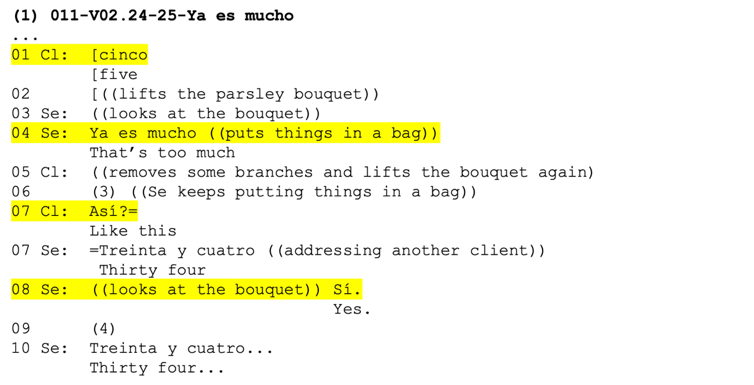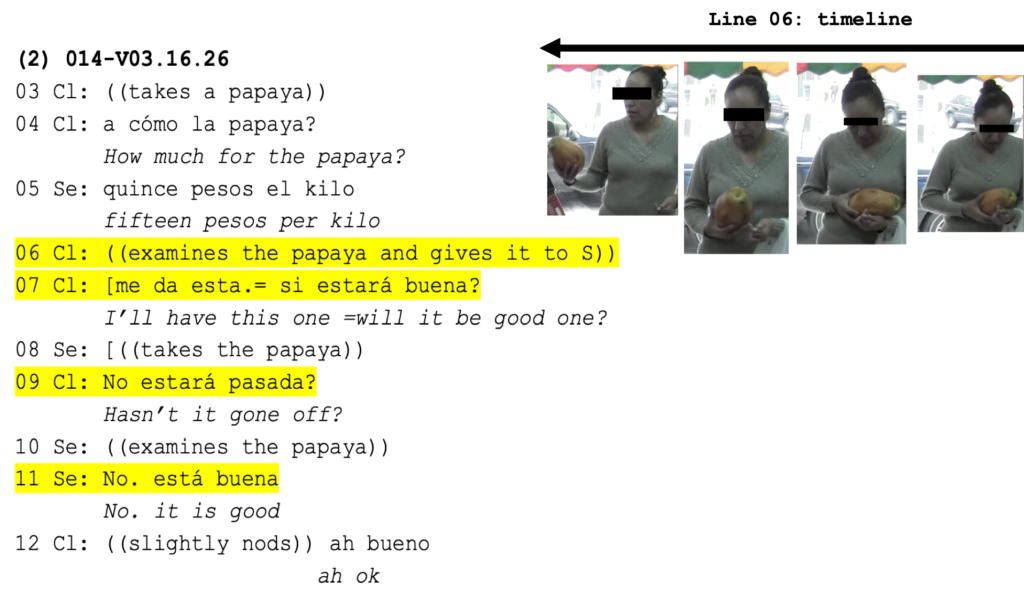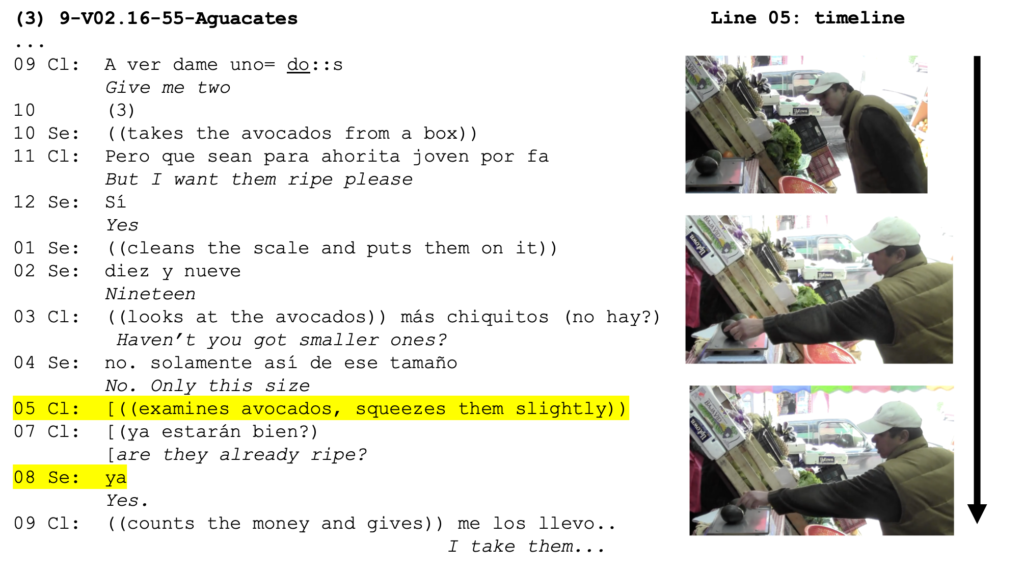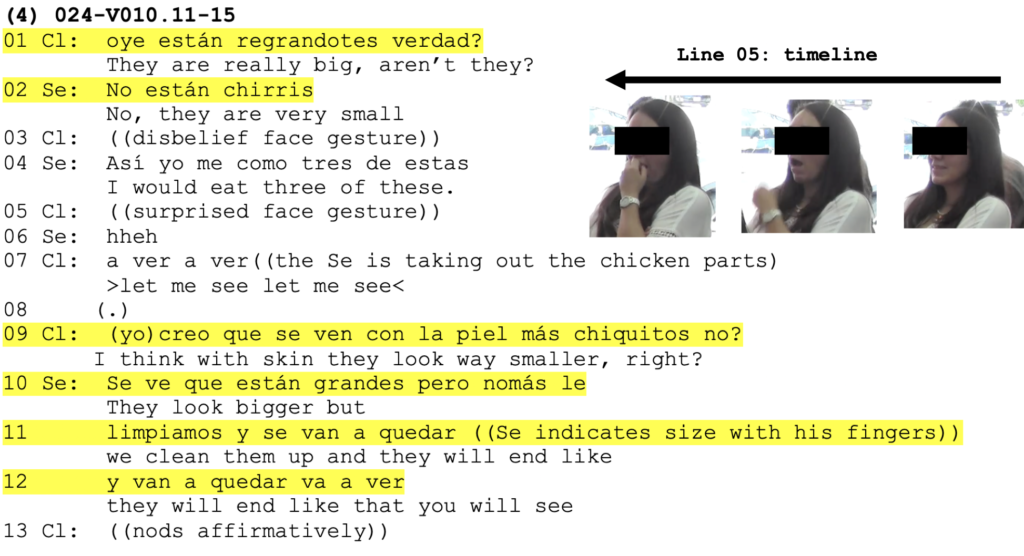A Squib by Dr Ariel Vázquez Carranza, lecturer at University of Guadalajara
[bg_collapse view=”button-red” color=”#ffffff” icon=”arrow” expand_text=”What’s a Squib?” collapse_text=”Hide this explanation” ]
In the EM/CA community, we all know the importance of “putting our work out there”: discussing our findings and impressions with other researchers is not only a way to avoid (or at least reduce) the risks of an individualistic analysis, but also, and above all, a precious resource for progressing and improving our work. Long before the publication in a journal, in the midst of the analytic process, collective scrutiny and discussions are fundamental practices to provide the researcher with suggestions, comments, references and even beneficial doubts.
For this reason, this section of the ISCA Forum Newsletter is dedicated to “squibs”: concise articles containing preliminary, in-process analyses in an EM/CA perspective. In this section, researchers can present their work-in-progress findings to the ISCA community in order to generate discussions and collect observations, suggestions, useful references and potential publication venues.
CALL FOR CONTRIBUTIONS
Would you like to share your in-process analysis to have some feedback? Send us your squib! Please note that your contribution should satisfy the following requirements: 1) not exceed 2000 words (2200 for non-English data); 2) contain one or two transcripts and relative preliminary analyses; 3) illustrate a phenomenon fitting within the existing framework of EM/CA analyses.
Please email your contribution to articles@conversationanalysis.org
[/bg_collapse]
1. Introduction
Epistemic asymmetry may be considered as a defining characteristic of institutional talk (Drew 1991; Drew and Heritage 1992): it is common to find institutional contexts where one of the participants has (professional) expertise in the business at hand; and such organisation of knowledge between the participants (i.e., one knowing more, K+, than the other, K-) outlines the sequential and linguistic design of the interaction (Heritage and Raymond 2005; Heritage 2013; Drew 2018). For instance, this has been described for medical encounters (e.g., Strong 1979; Silverman 1987; Maynard 1991; Heath 1992, inter alia), courtroom interactions (e.g., Drew 1992; Komter 1995; inter alia), guided tours (Mondada 2013), service encounters (Lee 2016), etc. In the present analysis I look at instances of epistemic asymmetry in a 25-hour corpus of commercial interactions in a Mexican fruit and vegetable shop. I focus on how the epistemic congruence is maintained.
2. Epistemic congruence and territories of knowledge
The epistemic status and stance of interactants are key aspects for the interactional display of epistemic asymmetry (Heritage 2012; 2013.). For example, in excerpt (1), the client (Cl) is buying a five-pesos parsley bouquet, she has collected some parsley branches and made the bouquet herself; at l. 01, she lifts the bouquet and says cinco (“five”). With such coordinated actions the client is asking the seller (Se) to confirm whether the bouquet is a five-pesos bouquet or not. Before the negative of the seller (ya es mucho, “that’s too much”), the client adjusts the bouquet and asks again, l. 07, the seller assesses the bouquet and this time agrees with the client, l. 8. This episode shows how the seller’s and client’s epistemic stance are compatible with their respective epistemic statuses; that is, the seller is knowledgeable with regard to what makes a five-pesos bouquet whereas the client is not. This excerpt is an instance of epistemic congruence.

In the institutional context at hand there are particular territories of knowledge that are made relevant interactionally, and each institutional role, i.e., the seller and client, displays their epistemic stance towards each domain according to their epistemic status, Table 2 shows this distribution. Product quality and product season are territories in which both, the client and the seller, may show they are knowledgeable, which may have sequential implications for the interaction.

The way clients show expertise in terms of product quality is by examining and assessing the product. In excerpts (2) and (3), for example, the clients examine the product, ls. 06 and 05 respectively, by observing and touching the product. In (2), after her product examination, the Cl produces two requests for confirmation, both with a contrastive format: at the end of l. 07, sí estará buena? (“will it be a good one?”) is a confirmation request that the papaya is a good one whereas her question at l. 09 (no estará pasada? “hasn’t it gone off?”) requests the opposite, i.e., that the papaya is off. By doing so, the Cl presents both scenarios to the Se (pasada vs. buena) projecting with this the epistemic asymmetry of the encounter. In other words, the physical examination of the product and the contrasting confirmation requests indicate that even though the Cl displays some sort of knowledge the Se has the definite evaluation of the papaya. Similarly, in (3), the Cl first physically inspects the product (the avocado) and then produces a confirmation request, in this case, the Cl only presents one scenario to the Se and once again the Se has the final word on it. In both excerpts, the physical product inspection made by the Cl displays some sort of expertise or knowledge about what a good product should be, but it does not endanger the epistemic asymmetrical context because, as both excerpts show, the Cl refers to the Se to assess the product as well and the latter always has the definite verdict. Furthermore, although the client provides the terms in which the product is assessed by the seller, the seller’s verdict is not contested by the client; in other words the epistemic congruence of the event is maintained.


There are cases, however, in which the seller’s verdict is indeed contested by the Cl. In excerpt (4), at l. 01, the Cl, after seeing the size of the chicken thighs the Se is preparing for her, downgrades her assessment about the size of the thighs which she considers big; in the next turn, the Se does not confirm the client’s evaluation, on the contrary, the Se assesses the thighs as being small, his assessment is received with a disbelief facial expression from the Cl. With such a gesture the Cl does not align to the epistemic asymmetry of the event, that is, she does not accept the seller’s evaluation. Before this misalignment from the Cl, the Se jokingly produces what seems to be an affiliative move: irony (Clift, 1999), the Se uses his ironic account to support his point of view, l. 04, which is received by the client with a surprised face gesture. As the Se is taking out the chicken thighs and putting them in the counter, the client once again reformulates her assessment on the size of the thighs and requests confirmation from the Se seeking agreement. The agreement does not come from the Se; instead, the seller provides a more elaborated account of his position, ls 10 and 11, his account displays technical knowledge with regard to the process that involves preparing the chicken thighs; furthermore, the Se commits to demonstrate to the Cl that after he finishes the work the thighs will reduce in size, l.12; to these actions, the client accepts the account by nodding affirmatively. This example shows how the epistemic status of the Se is somehow challenged by the client’s assessments of the product, to which the Se responds by producing contingency actions to mitigate the disagreement (e.g., with a joke) and assert his epistemic status by showing technical knowledge on the matter at hand.

3. Preliminary observations
Institutional identities, in this case “the seller” and “the client”, have particular epistemic territories. With respect to the knowledge about product quality, it is in both of their interests to have it and display it in order to fulfil one of their institutional goals, in this case, that of selling and buying, respectively, good quality products. Excerpts (2-4) show that clients are not epistemically passive participants; they display their knowledge in a multimodal manner, i.e., physically and linguistically. The client and the seller are oriented to maintain the expected epistemic asymmetry of the event; perhaps, the Se is more oriented to maintaining such asymmetry: when the seller faces disagreements from the client, he appeals to contingency actions to mitigate the disagreement and maintain the epistemic congruence of the event.
References
Clift, R. 1999. Irony in conversation. Language in Society, 28: 523-553.
Drew, P. 1991. Asymmetries of knowledge in conversational interactions. In I. Markova and K. Foppa (eds.), Asymmetries in dialogue. Hemel Hempstead, England: Harvester Wheatsheaf, pp. 21-48.
Drew, P. 1992. Contested evidence in courtroom cross-examination: the case of a trial for rape. In P. Drew and J. Heritage (eds.) Talk at Work: Interaction in Institutional Settings. Cambridge: Cambridge University Press, pp. 470 –520.
Drew, P. 2018. Epistemics in social interaction. Discourse Studies, 20 (1): 163-187.
Drew, P., & Heritage, J. 1992. Analyzing talk at work: An introduction. In P. Drew, & J. Heritage (eds.), Talk at work: Interaction in institutional settings. Cambridge, England: Cambridge University Press, pp. 3-65.
Heath, C. 1992. The delivery and reception of diagnosis in the general-practice consultation. In P. Drew, & J. Heritage (eds.), Talk at work: Interaction in institutional settings. Cambridge, England: Cambridge University Press, pp. 235–267.
Heritage, J. 2012. The Epistemic Engine: Sequence Organization and Territories of Knowledge. Research on Language and Social Interaction, 45(1): 30-52.
Heritage, J. 2013. Epistemics in conversation. In J. Sidnell, & T. Stivers (eds.), Handbook of conversation analysis Boston: Wiley-Blackwell, pp. 659–673.
Heritage, J. and Raymond G. 2005. The terms of agreement: Indexing epistemic authority and subordination in assessment sequences. Social Psychology Quarterly 68(1): 15–38.
Komter, M. 1995. The distribution of knowledge in courtroom interaction. Situated Order: Studies in the Social Organization of Talk and Embodied Activities. Washington, DC : University Press of America , pp. 107 –128.
Lee, S.-H. 2015. Service encounter discourse. In K. Tracy, C. Ilie, & T. Sandel (eds.), International encyclopedia of language and social interaction. Malden: John Wiley & Sons. pp. 1344–1348.
Lee, S.-H. 2016. Epistemic Asymmetry and Accountability in Service Interaction. In J. D. Robinson (ed.), Accountability in Social Interaction, Oxford: Oxford University press, pp. 175.
Maynard, D. 1991. On the interactional and institutional bases of asymmetry in clinical discourse. American Journal of Sociology, 92, 164–192.
Mondada, L. 2013. Displaying, contesting and negotiating epistemic authority in social interaction: Descriptions and questions in guided visits. Discourse Studies, 15(5): 597-627.
Strong, P. M. 1979. The ceremonial order of the clinic. London: Routledge.
Silverman, D. 1987.Communication and Medical Practice. Social Relations in the Clinic. London: Sage.
